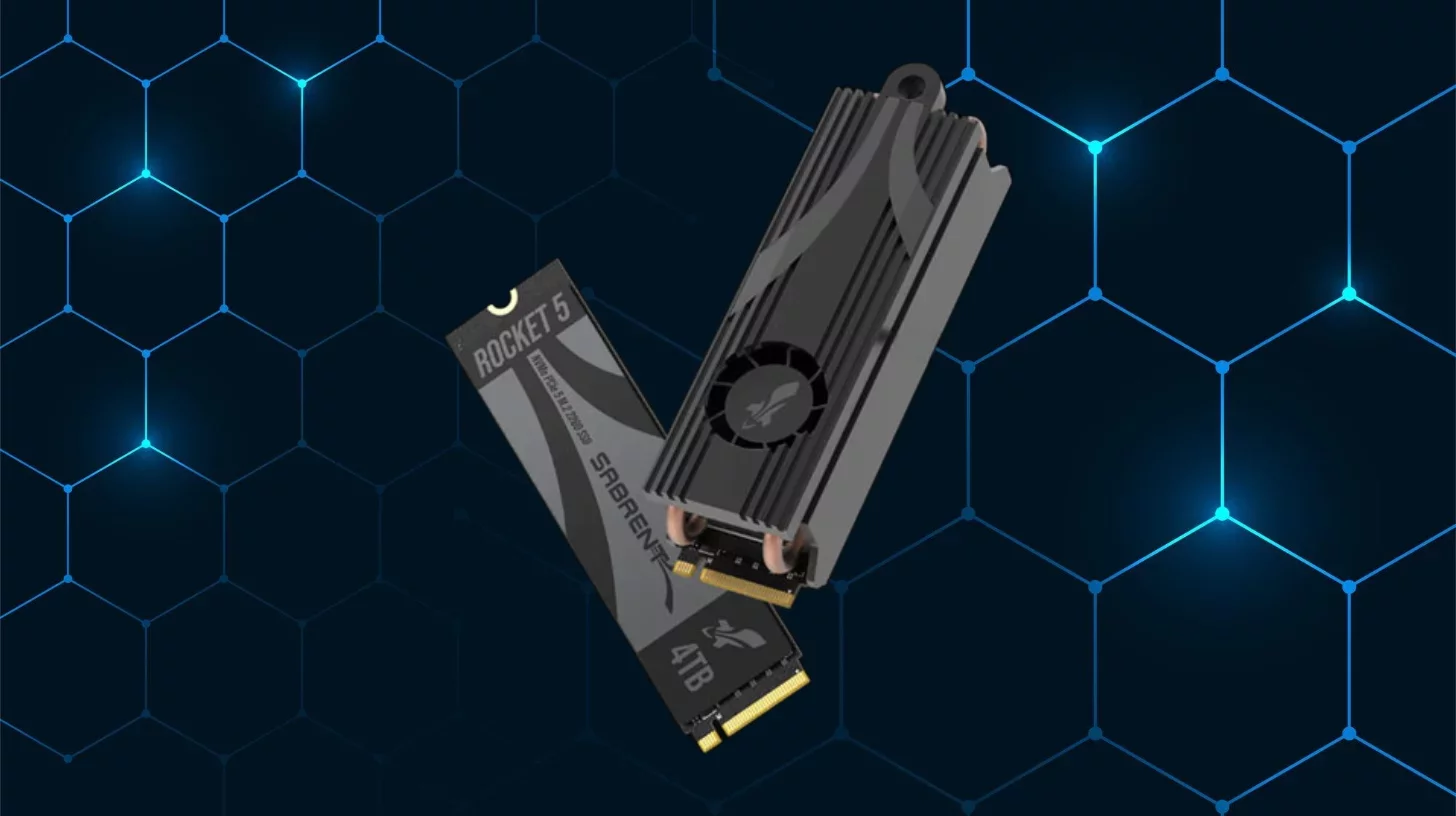
Sabrent Rocket 5
PCIe 5.0 Bandwidth Utilization | DirectStorage Optimization | Thermal Throttling Mitigation
Introduction
The Sabrent Rocket 5 emerges as a flagship PCIe 5.0 NVMe SSD, redefining high-performance storage for enthusiasts and professionals. Positioned as Sabrent’s fastest consumer SSD to date, it leverages PCIe 5.0’s doubled bandwidth over PCIe 4.0 to deliver sequential read speeds exceeding 14,000 MB/s. Its release marks a significant milestone in the evolution of storage technology, catering to workloads requiring instantaneous data access, such as 4K/8K video editing, AI-driven applications, and next-generation gaming.
Product Overview
The Rocket 5 employs a Phison E26 controller paired with Micron’s 232-layer 3D TLC NAND flash, available in 1TB, 2TB, and 4TB capacities. Designed for desktop environments with PCIe 5.0 support, it targets power users seeking to eliminate storage bottlenecks in creative workflows or gaming rigs. The drive omits an integrated heatsink, relying on motherboard-based cooling solutions or aftermarket thermal hardware for optimal operation.
Key Features
PCIe 5.0 Bandwidth Utilization
The Rocket 5 maximizes PCIe 5.0’s theoretical 32 GT/s transfer rate, achieving sequential read/write speeds of up to 14,000/12,000 MB/s. This enables rapid transfers of large datasets, such as 100GB game installations or 8K raw video files, in under 10 seconds.
DirectStorage Optimization
Microsoft’s DirectStorage API compatibility reduces game load times by bypassing CPU decompression bottlenecks. This feature ensures smoother texture streaming in titles like Cyberpunk 2077 and Microsoft Flight Simulator, particularly when paired with NVIDIA’s RTX 40-series or AMD’s RDNA 3 GPUs.
Thermal Throttling Mitigation
Sabrent’s firmware implements dynamic PCIe link-state downshifting (Gen5 → Gen4) when temperatures exceed 70°C, preventing catastrophic thermal throttling. Independent testing shows sustained workloads maintain drive temperatures at 60–65°C with adequate airflow.
Performance Analysis
Sequential Speeds
In synthetic benchmarks, the 2TB variant reaches 14,169 MB/s read and 12,756 MB/s write speeds using CrystalDiskMark. Real-world transfers of a 50GB video project complete 43% faster than PCIe 4.0 competitors like the Samsung 990 Pro.
Random Performance
The drive’s 1.4 million random read/write IOPS translate to sub-10µs latency during database transactions, outperforming enterprise SATA SSDs by 300%. Small-file operations (4KB) benefit from Phison’s CoXProcessor 2.0 architecture, which accelerates encryption and error correction.
Thermal Management
Without active cooling, the Rocket 5’s Phison E26 controller reaches 85°C under sustained writes, triggering throttling at the 5-minute mark. Sabrent’s optional heatsink reduces peak temperatures to 68°C through dual 6mm copper heat pipes and a 15CFM blower fan.
Compatibility
PlayStation 5
The Rocket 5 functions in Sony’s PlayStation 5 when paired with Sabrent’s PS5-specific heatsink (sold separately). Sequential speeds exceed the console’s 5,500 MB/s requirement, though real-world game load times match PCIe 4.0 drives due to software limitations.
Steam Deck and Handheld PCs
The 2280 form factor prevents direct installation in Valve’s Steam Deck. Handheld PCs with M.2 2280 slots (e.g., Ayaneo 2S) can utilize the drive but require thermal pads to offset increased power draw (5.5W active vs. 3.5W typical for PCIe 4.0 SSDs).
Raspberry Pi
Raspberry Pi’s USB 3.0 interfaces bottleneck the Rocket 5’s performance to 625 MB/s. The drive’s 3.3V power requirements exceed the Pi’s 1.2A USB port limitations, necessitating external power for stable operation.
Advantages and Limitations
Strengths
Unmatched PCIe 5.0 throughput for content creation
2,400TBW endurance rating (4TB model) ensures 657GB/day overwrites for 10 years
Backward compatibility with PCIe 4.0 motherboards without performance penalties
Constraints
8.9W peak power consumption necessitates 12V motherboard aux power connections
Incompatible with laptops lacking M.2 heatsinks
Premium pricing (2TB model costs 62% more than PCIe 4.0 equivalents)
Conclusion
The Sabrent Rocket 5 establishes itself as the premier choice for PCIe 5.0 early adopters requiring cutting-edge storage performance. While its thermal demands and power requirements limit compatibility with legacy systems, the drive delivers tangible benefits in DirectStorage-optimized games and data-intensive professional applications. Users with AMD X670E or Intel Z790 platforms will maximize its potential, particularly when configured with dedicated cooling solutions.
Works Cited
Harmon, William. “Sabrent’s Next-Gen Rocket 5 Gen 5 SSD Runs at Just 60°C Under Load Without Huge Heatsink.”
TweakTown, 4 Feb. 2024, www.tweaktown.com/news/95714/sabrents-next-gen-rocket-5-ssd-runs-at-just-60c-under-load-without-huge-heatsink/index.html.
Shilov, Anton. “Sabrent’s Rocket 5 SSD Rockets to 14,169 MB/s, Available Soon.” AnandTech, 8 Jan. 2024, www.anandtech.com/show/21212/sabrents-rocket-5-ssd-rockets-to-14169-mbs-available-soon.
“Sabrent Rocket 5 2TB SSD Review: Rocketing to New Heights.” Tom’s Hardware, 3 Apr. 2024, www.tomshardware.com/pc-components/ssds/sabrent-rocket-5-2tb-ssd-review.